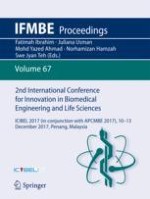2018 | Buch
2nd International Conference for Innovation in Biomedical Engineering and Life Sciences
ICIBEL 2017 (in conjunction with APCMBE 2017),10 - 13 December 2017, Penang, Malaysia
herausgegeben von: Prof. Fatimah Ibrahim, Dr. Juliana Usman, Dr. Mohd Yazed Ahmad, Dr. Norhamizan Hamzah, Dr. Swe Jyan Teh
Verlag: Springer Singapore
Buchreihe : IFMBE Proceedings
